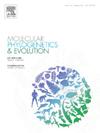Comprehensive phylogenetic analysis of newly detected rodent adenoviruses sheds light on ancient host-switches
IF 3.6
1区 生物学
Q2 BIOCHEMISTRY & MOLECULAR BIOLOGY
引用次数: 0
Abstract
Here we provide a comprehensive update on the diversity and genetic relatedness of adenoviruses occurring in rodents. Extensive PCR screenings revealed the presence of adenoviral DNA in samples originating from representatives of 17 rodent species from four different suborders of Rodentia. Distinct sequences of 28 different adenoviruses were obtained from the positive samples. Out of these, 20 were from hitherto unknown, putative novel adenoviruses, whereas 6 were variants of previously published murine adenoviruses. Additionally, two known viruses, guinea pig adenovirus 1 and squirrel adenovirus 1 were also detected. By PCR and primer walking, we determined the sequence of a considerable part of the genomic DNA of squirrel adenovirus 1, detected in red squirrel (Sciurus vulgaris) samples from Germany previously. We annotated the almost complete genome sequence of a novel mastadenovirus found by data mining in the bulk data of the Ord’s kangaroo rat (Dipodomys ordii) genome project. We revisited the sequence of the gene of E1B 19 K protein of mouse adenovirus 3. In contrast to the prototype strain, where a truncated version of this gene has been found, in our sample of mouse adenovirus 3, it seemed to be intact. Based on phylogeny reconstructions, all rodent adenoviruses clustered in the genus Mastadenovirus. Interestingly, however, there wasn’t a common monophyletic clade encompassing every adenovirus of rodent origin. Instead, three major lineages were observed. Because two lineages contained viral sequences deduced from samples of three suborders, and one consisted almost exclusively of adenoviruses from the family Muridae, we hypothesize there has been a long-term coevolution with the rodent hosts, as a result of possible ancient host-switch events. Several putative viruses appeared in distinct branches further away from the three clades. Thus, the evolutionary past of the adenoviruses of rodents remains to be studied further.

新发现的啮齿动物腺病毒的综合系统发育分析揭示了古代宿主开关。
在这里,我们提供了一个全面的更新的多样性和遗传关系的腺病毒发生在啮齿动物。广泛的PCR筛选显示,来自啮齿类动物4个不同亚目的17种啮齿类代表的样本中存在腺病毒DNA。从阳性样本中获得了28种不同腺病毒的不同序列。其中,20个来自迄今未知的假定的新型腺病毒,而6个是先前发表的小鼠腺病毒的变体。此外,还检测到豚鼠腺病毒1型和松鼠腺病毒1型两种已知病毒。通过PCR和引物步进,我们确定了以前在德国红松鼠(Sciurus vulgaris)样本中检测到的松鼠腺病毒1的相当一部分基因组DNA的序列。我们在Ord's kangaroo rat (Dipodomys ordii)基因组计划的大量数据中对一种新型乳腺病毒的几乎完整的基因组序列进行了注释。我们重新分析了小鼠腺病毒3型E1B 19 K蛋白的基因序列。与原型菌株相反,在我们的小鼠腺病毒3样本中发现了该基因的截断版本,它似乎是完整的。基于系统发育重建,所有啮齿动物腺病毒都聚集在乳突腺病毒属。然而,有趣的是,没有一个共同的单系进化枝涵盖所有起源于啮齿动物的腺病毒。相反,我们观察到三个主要的世系。由于两个谱系包含从三个亚目样本推断出的病毒序列,其中一个几乎完全由来自Muridae家族的腺病毒组成,我们假设由于可能的古代宿主转换事件,与啮齿动物宿主存在长期的共同进化。几种假定的病毒出现在远离这三个分支的不同分支上。因此,啮齿动物腺病毒的进化历史仍有待进一步研究。
本文章由计算机程序翻译,如有差异,请以英文原文为准。
求助全文
约1分钟内获得全文
求助全文
来源期刊
CiteScore
7.50
自引率
7.30%
发文量
249
审稿时长
7.5 months
期刊介绍:
Molecular Phylogenetics and Evolution is dedicated to bringing Darwin''s dream within grasp - to "have fairly true genealogical trees of each great kingdom of Nature." The journal provides a forum for molecular studies that advance our understanding of phylogeny and evolution, further the development of phylogenetically more accurate taxonomic classifications, and ultimately bring a unified classification for all the ramifying lines of life. Phylogeographic studies will be considered for publication if they offer EXCEPTIONAL theoretical or empirical advances.

 求助内容:
求助内容: 应助结果提醒方式:
应助结果提醒方式:


